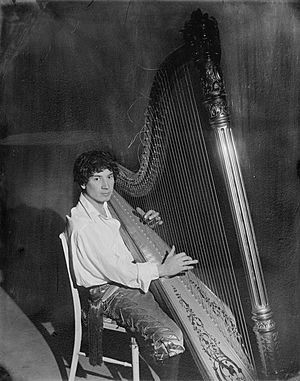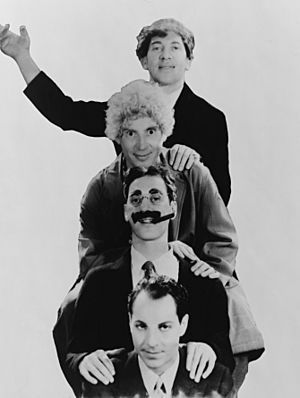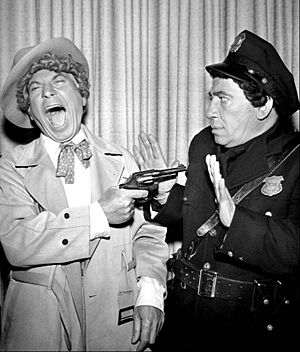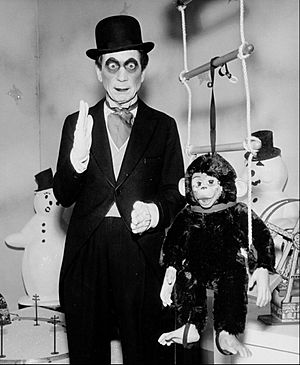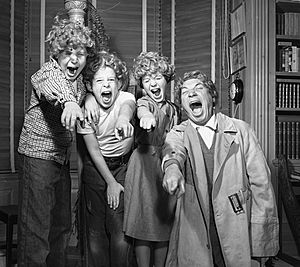Harpo Marx facts for kids
Quick facts for kids
Harpo Marx
|
|
|---|---|

Marx c. 1926
|
|
| Born |
Adolph Marx
November 23, 1888 |
| Died | September 28, 1964 (aged 75) Los Angeles, California, U.S.
|
| Occupation |
|
| Years active | 1910–1963 |
| Spouse(s) |
Susan Fleming
(m. 1936) |
| Children | 4 |
| Parent(s) |
|
| Relatives |
|
Arthur "Harpo" Marx (born Adolph Marx; November 23, 1888 – September 28, 1964) was a famous American comedian and actor. He was also a mime artist and played the harp. Harpo was the second-oldest of the famous Marx Brothers. Unlike his brothers Groucho and Chico, who used a lot of words in their comedy, Harpo's humor was mostly visual. He used vaudeville, clown, and pantomime styles. In his movies, he wore a curly reddish-blond wig and never spoke. Instead, he would blow a horn or whistle to talk. Harpo often used funny props, like a horn cane made from a lead pipe.
Contents
Early Life
Harpo was born on November 23, 1888, in Manhattan, New York City. He grew up in a neighborhood called Carnegie Hill in New York. This area was home to many European immigrants.
His parents were Sam Marx, known as "Frenchie," and Minnie Schoenberg Marx. Minnie was the sister of comedian Al Shean. Harpo's family was Jewish. His mother was from Germany, and his father was a tailor from France.
Harpo did not go to school for very long. He left New York Public School 86 when he was eight years old. This was mainly because he was bullied. After leaving school, he started working many different odd jobs. He worked with his older brother Chico to help his family earn money. Some of his jobs included selling newspapers, working in a butcher shop, and being an office errand boy.
Career
On Stage
In January 1910, Harpo joined two of his younger brothers, Julius (later "Groucho") and Milton (later "Gummo"). They formed a group called "The Three Nightingales." This group later became known as "The Marx Brothers."
There are different stories about why Harpo became the "silent" character. Groucho wrote in his book that Harpo wasn't very good at remembering lines. So, it made sense for him to play a character who didn't speak.
The name "Harpo" came from a card game. The dealer, Art Fisher, called him "Harpo" because he played the harp. Harpo learned to play the harp by himself. He saw a picture of an angel playing a harp and copied how the angel held it. He tuned the harp the best he could without lessons. Three years later, he found out he had tuned it incorrectly. But his way put less stress on the strings. Even though Harpo was a talented musician, he never learned to read or write music.
Harpo also played the piano. He and Chico sometimes played piano to go along with silent films. Harpo only knew two songs on the piano. He would play them at different speeds to match the movie's action. Later, he let Chico play the piano and focused on his trademark harp.
Harpo changed his first name from "Adolph" to "Arthur" by 1911. He didn't like the name "Adolph."
On Film
Harpo's first movie was Humor Risk (1921) with his brothers. But this film was shown only once and then lost. Four years later, Harpo appeared alone in Too Many Kisses (1925). In this silent film, Harpo spoke his only line ever on camera: "You sure you can't move?" The audience saw his lips move and the words on a title card.
Harpo was often Chico's funny partner. He would help Chico by using charades to explain Groucho's problems. He also liked to annoy Chico by giving him his leg instead of a handshake.
Harpo was famous for his visual jokes using props. He seemed to have an endless number of strange things in his large coat pockets. In the movie Horse Feathers (1932), Groucho told Harpo he couldn't "burn the candle at both ends." Harpo immediately pulled a lit candle burning at both ends from his pocket. In the same movie, a homeless man asked Harpo for money for coffee. Harpo then pulled out a steaming cup of coffee, with a saucer, from his coat.
Harpo often used funny faces and mime to express himself instead of speaking. One of his famous facial expressions was called "the Gookie." He made this face by copying a tobacconist who made a similar face while rolling cigars.
Harpo also wore a "fright wig." At first, it was dyed pink. Later, he changed it to a reddish color. In some movies, it looked blond because of the black-and-white film.
The other Marx Brothers sometimes joked about Harpo not speaking. They made it clear that his character chose not to speak. The idea for him to be silent came after a bad review. The review said Harpo's acting as a fool was only good until he spoke. Later, his uncle wrote a script where Harpo had only three lines. Harpo joked, "Well, maybe I won't talk at all!" His uncle liked the idea, and it stuck.
In later movies, Harpo often tried to share important messages by whistling and miming. This showed that his character couldn't speak. In the movie At the Circus (1939), Harpo sneezed and said "A-choo!" twice. This was a rare moment where he made a sound like talking.
Tour in the Soviet Union
In 1933, Harpo visited Moscow, Russia, for six weeks. He performed and acted as a goodwill ambassador. His shows were very popular. Harpo's name was written in Russian as "ХАРПО МАРКС." Harpo became friends with the Soviet Foreign Minister, Maxim Litvinov, and they even performed together on stage.
During this trip, Harpo secretly carried messages for the US Ambassador. He would tape sealed envelopes to his leg under his trousers. He was very relieved when the trip was over and he could finally scratch his leg!
In Other Media
In 1936, Harpo appeared as a cartoon character in Walt Disney's Mickey's Polo Team. He was shown riding an ostrich. Walt Disney also featured Harpo, along with Groucho and Chico, in the cartoon Mother Goose Goes Hollywood.
Harpo was also shown as a cartoon character in the Popeye cartoon Sock-A-Bye Baby (1934). He was also in the Merrie Melodies cartoon The Coo-Coo Nut Grove (1936).
Harpo also enjoyed painting. Some of his artworks are in his autobiography. The famous artist Salvador Dalí drew a picture of Harpo. They were friends.
Harpo recorded several albums of harp music. He made Harp by Harpo (1952) and two others for Mercury Records.
Harpo appeared on TV shows in the 1950s and 60s. In 1955, he was on I Love Lucy. He and Lucille Ball re-created the famous mirror scene from the movie Duck Soup. Both Harpo and Lucille Ball dressed up as Harpo. He also appeared on The Martha Raye Show around 1950. In 1959, Harpo and Chico were on General Electric Theater in a silent episode. Groucho made a surprise appearance at the end.
In 1960, Harpo acted in his first serious role in A Silent Panic. He played a deaf-mute man who saw a crime. In 1961, to promote his book Harpo Speaks!, he appeared on many TV shows. These included The Today Show and Candid Camera.
In November 1961, he was a guest star with Carol Burnett on The DuPont Show of the Week. He played "Autumn Leaves" on the harp. His last TV appearances were in late 1962. He played a guardian angel on The Red Skelton Hour. His very last role was as himself on Mr. Smith Goes to Washington.
Personal Life
Harpo married actress Susan Fleming on September 28, 1936. Their marriage became public when President Franklin D. Roosevelt sent them a congratulatory message. Harpo and Susan adopted four children: Bill, Alex, Jimmy, and Minnie. Harpo once said he wanted to adopt as many children as he had windows in his house. He wanted a child waving goodbye from every window when he left for work.
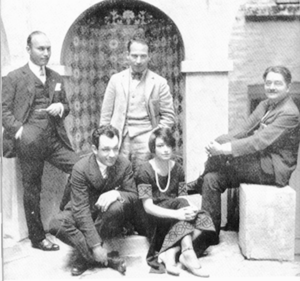
Harpo was good friends with theater critic Alexander Woollcott. He was a regular member of the Algonquin Round Table, a group of writers and artists. Harpo said his main role there was to listen to the jokes of others. In their play The Man Who Came to Dinner, George S. Kaufman and Moss Hart based the character "Banjo" on Harpo. Harpo later played this role in Los Angeles.

In 1961, Harpo published his autobiography, Harpo Speaks!. Because he never spoke in his characters, many people thought he was actually mute. But he could speak. Recordings of his voice can be found online and in documentaries. Reporters who interviewed him said he had a deep and clear voice. His son, Bill, remembered that Harpo had a deep, soft voice in private. He preferred to listen rather than talk a lot, unlike his brothers.
Harpo's last public appearance was on January 19, 1963. He announced his retirement. Comedian Steve Allen was there and remembered that Harpo spoke for several minutes about his career. Harpo was also a big fan of croquet. He was added to the Croquet Hall of Fame in 1979.
Death
Harpo Marx died on September 28, 1964, at age 75. He passed away in a hospital in West Los Angeles after heart surgery. Harpo's death was very sad for his surviving brothers. Groucho's son, Arthur Marx, said it was the only time he ever saw his father cry.
In his will, Harpo Marx gave his famous harp to the country of Israel. It was later used in an Israeli orchestra. His body was cremated, and some of his ashes were scattered at a golf course in Rancho Mirage, California. He was survived by his wife Susan, his four children Bill, Alex, Jimmy, and Minnie, and his younger brothers Groucho, Gummo, and Zeppo.
Legacy
Harpo's famous look included a trench coat with huge pockets, a red wig (though it looked blond in black-and-white films), a top hat, his funny horn, and his harp. His talent made him famous around the world. He performed in movies and on stage. He also played the piano and clarinet, mostly teaching himself. Harpo's son Bill also became a musician, playing his own songs on the piano. In 2002, Harpo was honored with a Golden Palm Star on the Palm Springs, California, Walk of Stars.
Harpo was often invited to parties by newspaper owner William Randolph Hearst.
Media Portrayals
Actors have played Harpo Marx in different shows:
- J. M. Henry played him in the 1994 film Mrs. Parker and the Vicious Circle.
- Daniel Fortus played him in the Broadway musical Minnie's Boys (1970). This show was about the early days of the Marx Brothers.
- Actress Priscilla Lopez played Gino, a character based on Harpo, in the 1980 Broadway show A Day in Hollywood/A Night in the Ukraine. She won an award for this role.
- Les Marsden played Harpo in Groucho: A Life in Revue. This play was written by Groucho's son, Arthur Marx.
Filmography
Film
| Year | Title | Role | Notes |
|---|---|---|---|
| 1921 | Humor Risk | Watson | Short, lost |
| 1925 | Too Many Kisses | The Village Peter Pan | |
| 1929 | The Cocoanuts | Harpo | |
| 1930 | Animal Crackers | The Professor | |
| 1931 | The House That Shadows Built | The Merchant of Wieners | |
| 1931 | Monkey Business | Harpo | |
| 1932 | Hollywood on Parade, #A-5 | Himself | Short |
| 1932 | Horse Feathers | Pinky | |
| 1932 | Hollywood on Parade, #11 | Himself | Short |
| 1933 | Duck Soup | Pinky | |
| 1935 | A Night at the Opera | Tomasso | |
| 1935 | La Fiesta de Santa Barbara | Himself | Short |
| 1937 | A Day at the Races | Stuffy | |
| 1938 | Room Service | Faker Englund | |
| 1939 | At the Circus | 'Punchy' | |
| 1940 | Go West | 'Rusty' Panello | |
| 1941 | The Big Store | Wacky | |
| 1943 | Stage Door Canteen | Harpo Marx | |
| 1945 | All Star Bond Rally | Himself | |
| 1946 | A Night in Casablanca | Rusty | |
| 1949 | Love Happy | Harpo | |
| 1957 | The Story of Mankind | Sir Isaac Newton | |
| 1962 | Got It Made | lost |
TV
| Year | Title | Role | Notes |
|---|---|---|---|
| 1952 | The Ezio Pinza Show | Himself - Comic Actor | 1 episode |
| 1952-1953 | All Star Revue | Himself | 3 episodes |
| 1953 | Season's Greetings | Himself | TV movie |
| 1954 | The Colgate Comedy Hour | Governor | 1 episode |
| 1955 | I Love Lucy | Himself | 1 episode |
| 1957 | Playhouse 90 | 1 episode | |
| 1958 | The DuPont Show of the Month | Narrator | 1 episode |
| 1959 | General Electric Theater | Nick | 1 episode |
| 1960 | The DuPont Show with June Allyson | Benson | 1 episode |
| 1961 | The DuPont Show of the Week | Himself | Episode: The Wonderful World of Toys |
| 1962 | The Red Skelton Hour | Guardian Angel | 1 episode |
| 1962 | Mr. Smith Goes to Washington | Himself | 1 episode (final appearance) |
Discography
- 1952 Harp by Harpo
- 1957 Harpo in Hi-Fi
- 1958 Harpo at Work!
See also
 In Spanish: Harpo Marx para niños
In Spanish: Harpo Marx para niños



